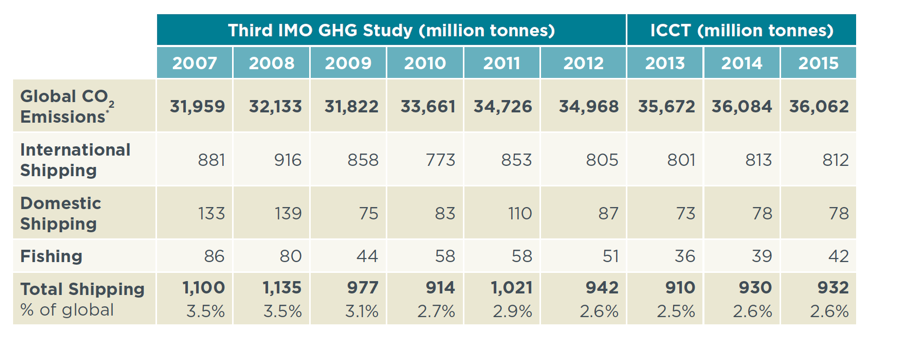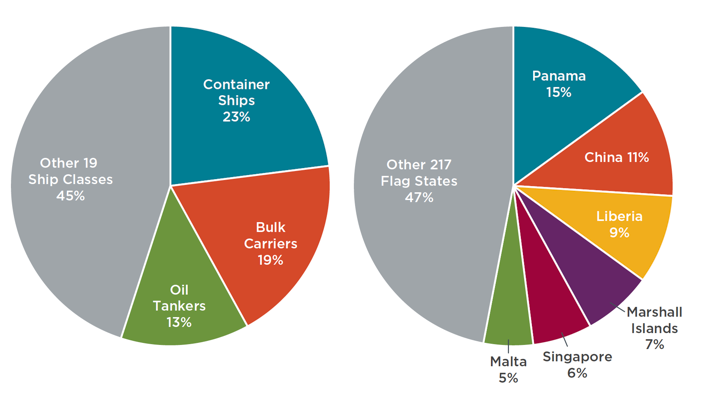Whac-A-Mole on the high seas: The curious case of ship emissions
Press release
Study: Global shipping emissions rise as IMO meets to discuss climate action
Emissions of greenhouse gases (GHGs) from global shipping are on the rise again, according to a study released today by the International Council on Clean Transportation (ICCT). This finding increases pressure on policymakers gathering at the International Maritime Organization (IMO) headquarters next week to take action on climate change.
The new study combines state of the art global ship operations (AIS) data with detailed vessel characteristics for more than half a million ships to estimate GHG emissions and air pollution from shipping at high resolution (1° x 1°) on an hourly basis for the years 2013 to 2015. Overall, maritime fuel consumption increased from 291 to 298 million tonnes (+2.4%) from 2013 to 2015, compared to a 7% increase in shipping transport work. Accordingly, carbon dioxide (CO2) emissions from global shipping (oceangoing vessels, domestic ships, and fishing vessels) increased from 910 to 932 million tonnes over the same period (Table).

The study highlights that three ship classes and six flag states (country of registration) are responsible for the majority of emissions (Figure). Container ships (23%), bulk carriers (19%) and oil tankers (13%) accounted for more than half of CO2 emissions. In terms of flag states, ships registered to Panama (15%), China (11%), Liberia (9%), Marshall Islands (7%), Singapore (6%), and Malta (5%) were the largest emitters. These flags account for 66% of the global shipping fleet’s deadweight tonnage.

The study shows that improvements in ship efficiency were outpaced by increases in transport supply over the period studied, driving GHGs and air pollution higher. One contributing factor to this trend is that the biggest ships are speeding up and emitting more. While average speeds remained largely flat between 2013 and 2015 for most ships, the largest oil tankers and container ships sped up nearly 4% and more than 11%, respectively. The study also identifies black carbon as the second most important climate pollutant after CO2, representing between 7 and 21% of the total climate impact of shipping.
“When IMO last looked at this in 2014, shipping emissions had dropped after the Great Recession,” said Naya Olmer, the lead author on the report. “We now know that the pendulum has swung back, with emissions again on the rise as global trade expands.” “This study shows that business as usual improvements in shipping efficiency will not be enough to reduce GHG emissions from ships,” said Dan Rutherford, the ICCT’s program director for marine and one of the paper’s coauthors. “Concerted action is needed from IMO to promote low and even zero carbon technologies if the shipping industry is to pull its weight in protecting the global climate,” he added.
The shipping industry is a major emitter of climate pollution. If it were a country, the global marine transportation sector would have ranked 6th in terms of carbon dioxide (CO2) emissions in 2015, just below Germany and well above Korea. Marine CO2 emissions are projected to double by 2050 as international trade expands unless effective policies are developed to constrain emissions growth. Countries, industry representatives, and non-governmental organizations will gather the week of October 23rd in London to develop IMO’s comprehensive GHG strategy for ships, which could include a cap on ship GHG emissions. International shipping was not included in the landmark 2015 Paris climate agreement.
Download the study here.
Publication details
Greenhouse gas emissions from global shipping, 2013–2015 (.pdf)
Authors: Naya Olmer, Bryan Comer, Biswajoy Roy, Xiaoli Mao, and Dan Rutherford
Available at: http://theicct.org/publications/GHG-emissions-global-shipping-2013-2015
Contacts:
- Bryan Comer, 202.407.8345, bryan.comer@theicct.org
- Naya Olmer, 415.399.9019, n.olmer@theicct.org
